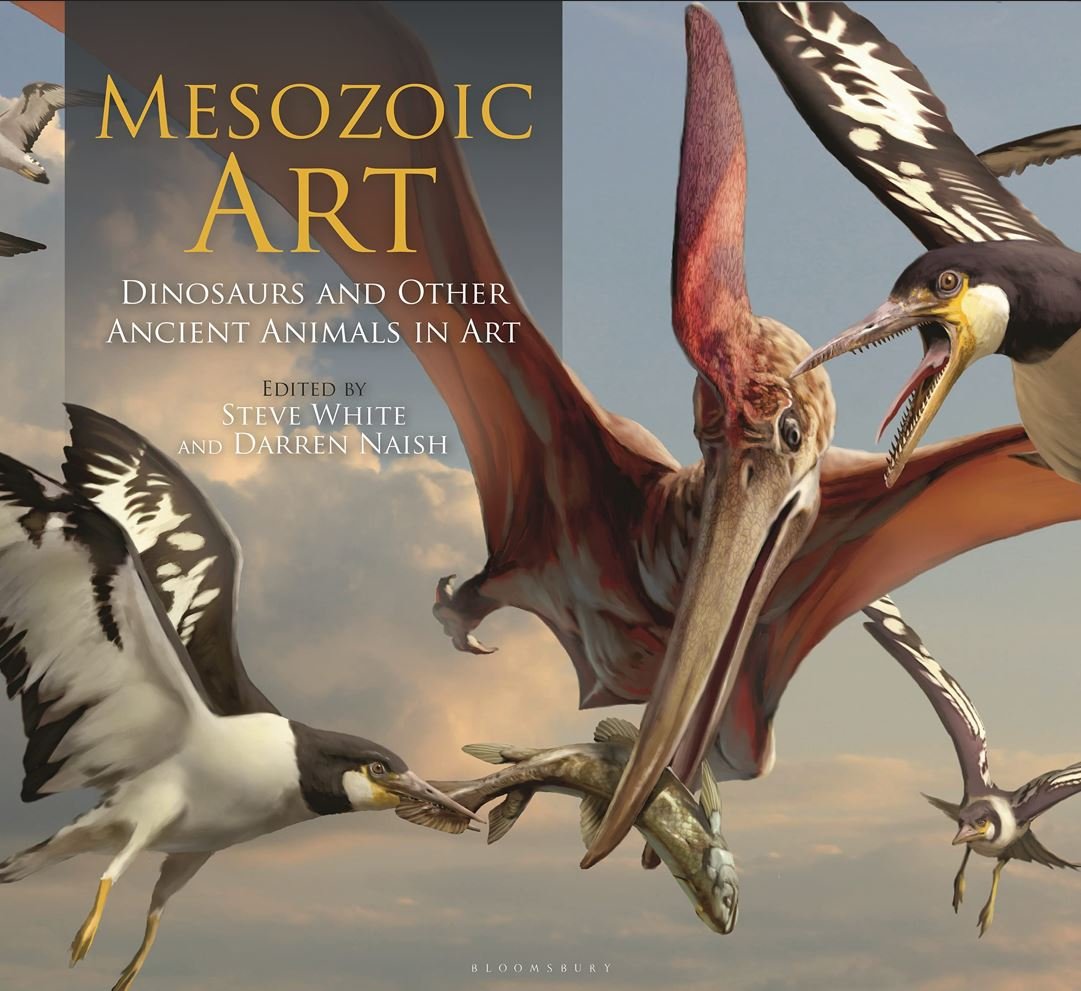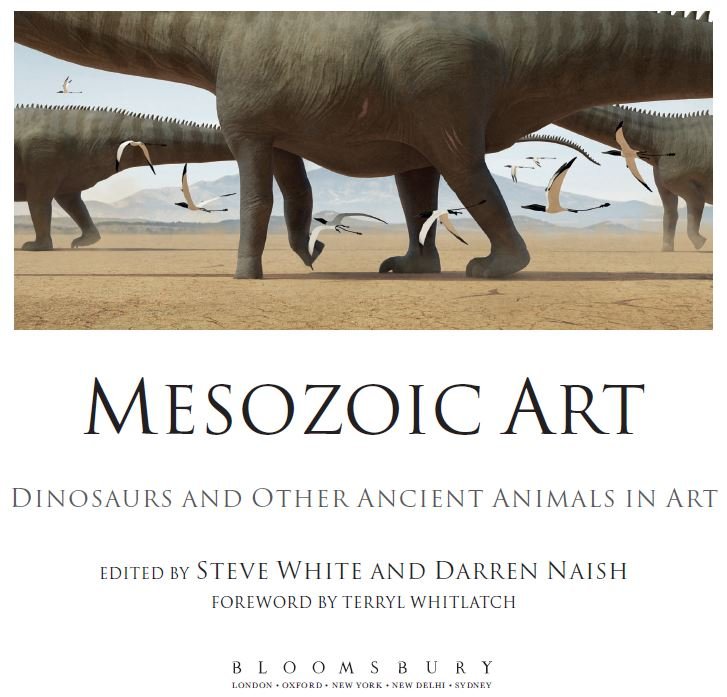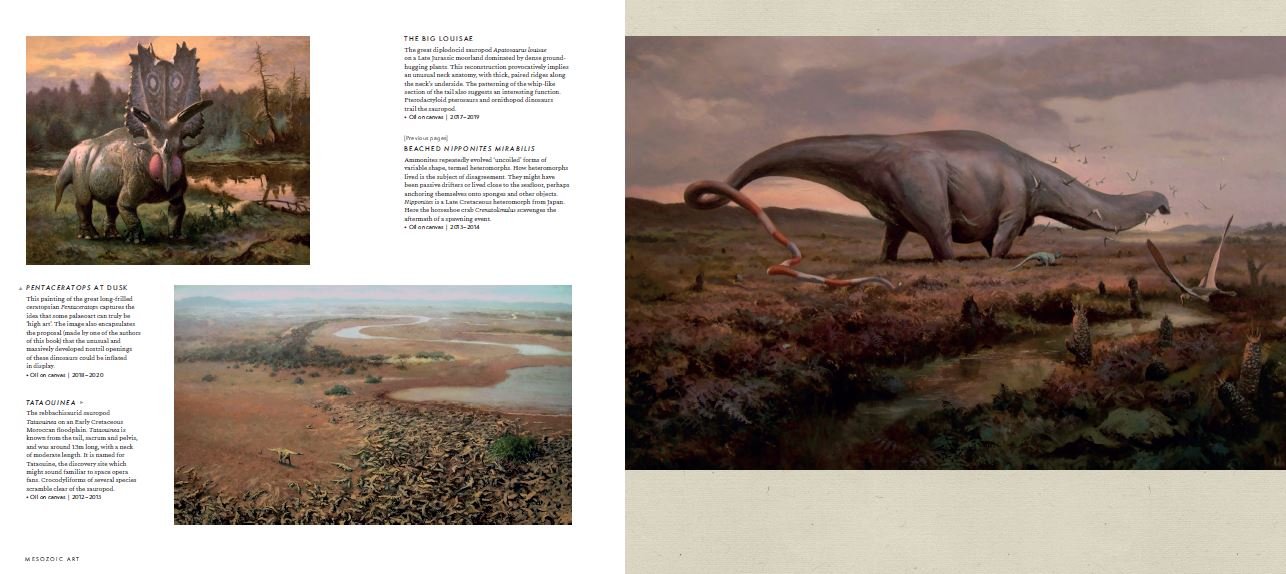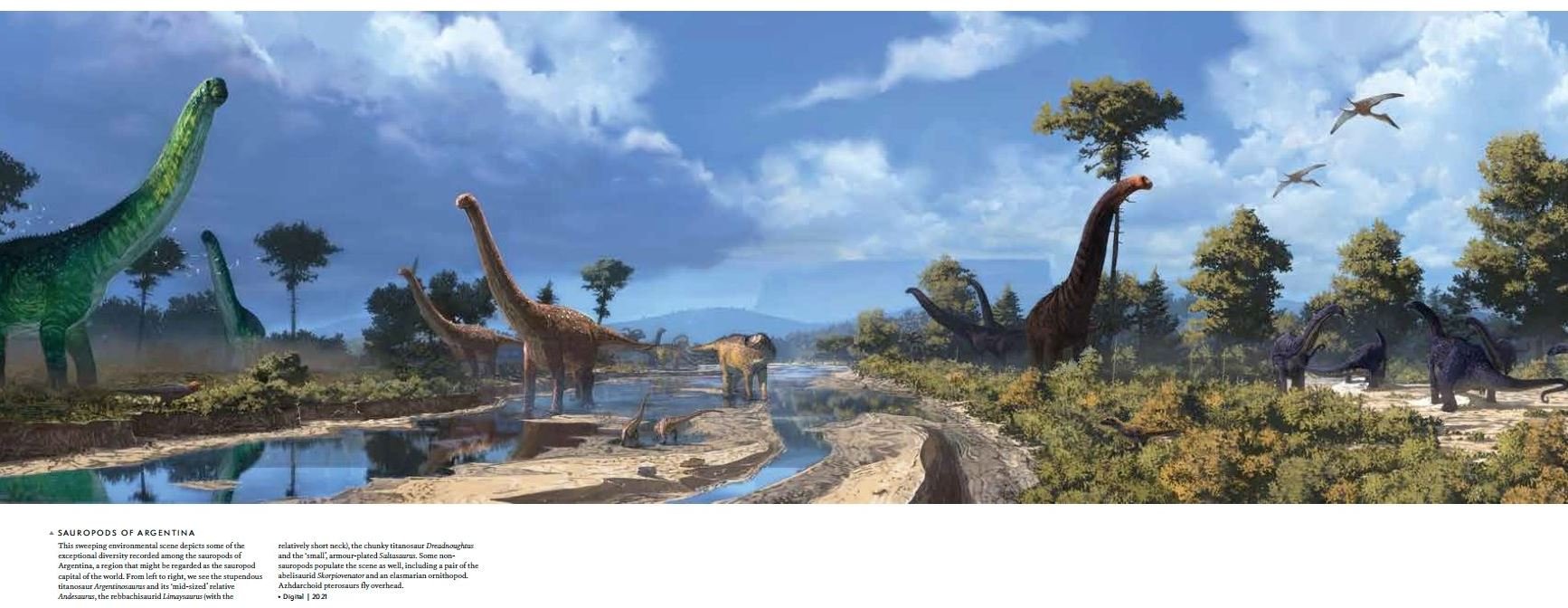The giant, fantastically illustrated new volume Mesozoic Art: Dinosaurs and Other Ancient Animals in Art, edited and written by Steve White and myself and published by Bloomsbury Wildlife, is now on sale…
Mesozoic Art – approximately similar in size, format and style to its successful predecessors Dinosaur Art: the World’s Greatest Paleoart (White 2012) and Dinosaur Art II: the Cutting Edge of Paleoart (White 2017) – is a big book (31 cm by 28 cm, 208 pages long), broken down into 20 sections, each devoted to the work of a specific active modern palaeoartist.
Caption: welcome to Mesozoic Art! The image there is by Julio Lacerda and features at much larger size in the relevant section.
In the order in which they’re covered, these are Gabriel Ugueto, Joschua Knüppe, Corbin Rainbolt, Stephanie Dziezyk, Emiliano Troco, Lucas Attwell, Júlia d’Oliveira, Midiaou Diallo, Joanna Kobierska, Jed Taylor, Pablo Rivera, Greer Stothers, John Conway, Ville Sinkkonen, Danielle Dufault, Julio Lacerda, Brennan Stokkermans, Raven Amos, Mark Witton and Jaime Chirinos. It should be obvious that the people Steve and I selected for inclusion are mostly ‘early career’ palaeoartists, their work very much reflecting cutting edge thinking on palaeoartistry.
Many of our artists have been commissioned to produce recent work for museums and publications or are highly active and hence aware of new discoveries relevant to the field. Consequently, a high percentage of the illustrations feature recently described or brand-new animals. To take just a few examples, Danielle Dufault’s images depict a variety of recently published Burgess Shale invertebrates, while Brennan Stokkermans’s selection includes depictions of the new pterosaurs Kunpengopterus, Leptostomia and the Hansandong boreopterid. Several visions of Spinosaurus – very much reflecting our constantly evolving view of what this dinosaur was like – appear throughout the book. To quote from Midiaou Diallo’s section, “Spinosaurus may well end up being the most frequently illustrated Mesozoic dinosaur – probably after Tyrannosaurus – of the current age” (White & Naish 2022, p. 83).
A reasonable diversity of artistic styles is featured. The bulk is digital but (to quote from our section on Ville Sinkonnen) “There is no indication that the digital revolution has ‘killed’ traditional media” (White & Naish 2022, p. 145) and pieces produced in gouache (Knüppe), watercolour (Sinkonnen), oils (Troco), acrylics (Knüppe, Dziezk and d’Oliviera), pencil (d’Oliviera again), acrylic-gouache-pencil hybrid (Knüppe) or as Risograph prints (Stothers) are present, as are pieces designed to resemble woodblock art (Amos) or be expressionistic (Conway). Emiliano Troco’s fabulous paintings are actual physical oil-on-canvas works that you can visit in a studio (a nod to my associate Andrea Cau for introducing me to Troco’s work in the first place. How I long to own one of them).
Caption: just two of the several pages devoted to the work of Emiliano Troco that feature in Mesozoic Art.
It should also be obvious that our included artists have a fair amount of diversity in terms of geographical origins, though it remains the case that some substantial sections of the world remain poorly represented in the palaeoart realm. This will undoubtedly change in time.
Size, quality, text. Mesozoic Art is predominantly devoted to the art it contains, which is printed at the greatest size and quality possible. We tend not to talk about print quality when discussing books, but we should. The high resolution and vibrancy of the colours means that we’re presenting the art as best as humanly possible. Huge thanks and congratulations to the publishing team at Bloomsbury for their work here.
Caption: part of our section on the amazing art of Venezuelan-born herpetologist and artist Gabriel Ugueto, here concentrating on marine animals. Gabriel is one of several artists whose images have done much to increase interest in Mesozoic marine reptiles. Someone really should write a book on those animals that features his art, shouldn’t they? Such a book will appear in print in 2023. Stay tuned.
Our accompanying text is brief but hopefully provides some interesting background to the art and the animals it depicts. We also feature potted biographies of the artist themselves. We’re very grateful to the amazing Terryl Whitlatch for the foreword she very kindly provided.
Why ‘Mesozoic Art’, and not ‘Dinosaur Art’ or such? As explained in the Introduction (subtitled ‘The Dinosaur Enlightenment’), our aim with this book was to showcase several things simultaneously: the cutting-edge, beautiful and technically sophisticated work of the current generation of palaeoartists, the ‘new look’ that many of these artists are giving their animals, and the diversity of styles and media now evident.
Caption: animals of today are animals of the past when imagined or seen in the right way; similarly, the animals of the past can often be transposed to the present if environments and conditions are right. I know I’m not the only one who looks at animals and environments in this way. Image: Darren Naish.
Also paramount is the fact that palaeoart is functioning as ‘wildlife art from time-travellers’: there’s abstract stuff in there, sure, but most work aims to depict animals, engaging in behaviour as if witnessed alive in their environments. The consequence is that palaeoartistic scenes often remind us of modern scenes we’ve observed with our own eyes, and – in turn – that many modern scenes give us a “that would make good palaeoart” feeling (a quote I stole from LITC blogger Marc Vincent). And another consequence is that the art concerned involves animals from across the whole of prehistory. It isn’t just about dinosaurs. The title ‘Mesozoic Art’ is our attempt to capture the idea that palaeoart involves a way of looking at the world “through a prehistoric prism … the more things change, the more they stay the same” (White & Naish 2022 p. 7).
Caption: the latest in what can loosely be regarded as a series…
Buying Mesozoic Art. Already, Mesozoic Art is selling extremely well and there’s been an extraordinary amount of interest. We’re extremely proud of it, hope that the artists whose work we feature are as happy with it as are Steve and I, and hope that you’ll buy a copy too. It’s extremely affordable for its size (£30 in the UK, $40 in the US).
On that note, Mesozoic Art is available directly from Bloomsbury here (this is the best option if you’re in the UK) and from digital retailers as normal. It’s also available from standard retailers; ask for it at your local bookstore.
Finally, the far-flung nature of our many contributors means that we just aren’t able to get everyone together for a signing event, alas. The closest we have to that is the event at TetZooCon 2022 (3rd and 4th December, London), where no less than seven people involved in the book will be present in the same place at the same time. We’re selling and signing copies with the co-operation of our friends at Bloomsbury, so do come along!
Caption: a giant spread featuring a diversity of Argentinean sauropods, by Corbin Rainbolt. The image would function well as a giant mural.
For previous TetZoo articles on other palaeoart books, see
The Great Dinosaur Art Event of 2012, November 2012
All Yesterdays: Unique and Speculative Views of Dinosaurs and Other Prehistoric Animals – the book and the launch event, December 2012
Artistic Depictions of Dinosaurs Have Undergone Two Revolutions, September 2014
Refs - -
White, S. 2012. Dinosaur Art: the World’s Greatest Paleoart. Titan Books, London.
White, S. 2017. Dinosaur Art II: the Cutting Edge of Paleoart. Titan Books, London.












